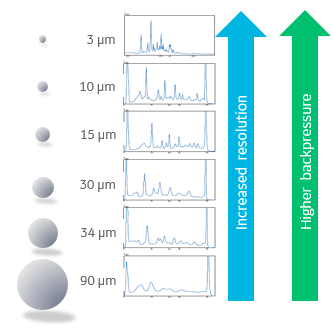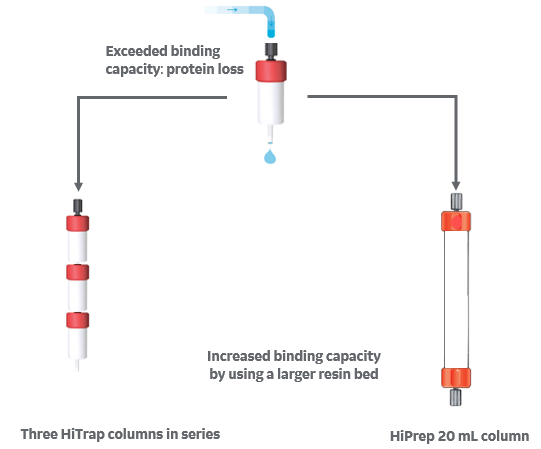With the right understanding, ion exchange chromatography (IEX) can be a powerful tool for protein separation. We recently learned more about IEX during Marianne Carlsson’s webinar “Tips for successful ion exchange chromatography”. Here, I share two important takeaways from this webinar.
1. Using smaller resin bead sizes will improve the purity of your protein
Protein purity and peak resolution in the chromatogram are directly correlated. The higher resolution you have, the purer your proteins.
Figure 1 illustrates the influence of particle size on resolution by comparing several IEX resins under the same running conditions: resolution increases with decreasing particle size.
On the other hand, smaller particles often create an increase in back pressure and can cause column bed compression, column leakage, as well as breakage of system components if the flow rate is not decreased. Thus, smaller particles give higher resolution but run times can possibly be longer.
Therefore, it is very important to take the time to select your chromatography resin, depending on your specific needs: speed versus protein purity.
Fig 1. Influence of resin bead size on resolution and backpressure.
Other factors can have an influence on the resolution in ion exchange chromatography, such as:
- Flow rate
- Sample load
- Gradient slope
- Dirtiness of the column
- Tubing diameters and lengths
Learn more about how these other factors can help optimize the resolution of your IEX runs by watching the webinar on demand.
2. Ensure proper protein recovery by using a correct amount of resin
High protein binding capacity is important for high protein recovery
To optimize protein recovery, it is important to ensure that your protein binds properly to the resin.
Low yield of your target protein can occur because the protein binding capacity of the resin has been exceeded. Then, more resin is needed to bind your protein.
How can the protein binding capacity be increased?
Two options are possible, as shown in the Table 1.
| Connect columns in series | Use a larger column format |
| If using HiTrap columns, | Another option to increase binding is to use a larger prepacked column such as, for example, a HiPrep IEX column, which contains 20 mL of resin. |
Fig 2. Illustration of how binding capacity can be increased.
There might be other reasons for poor protein binding, such as:
- Using incorrect ion exchanger
- Sample has wrong pH or incorrect buffer conditions
- Column is not equilibrated sufficiently in buffer
- Column is dirty
Learn more about how you can address these potential issues to maximize your protein recovery during your IEX runs: watch the webinar on demand!

